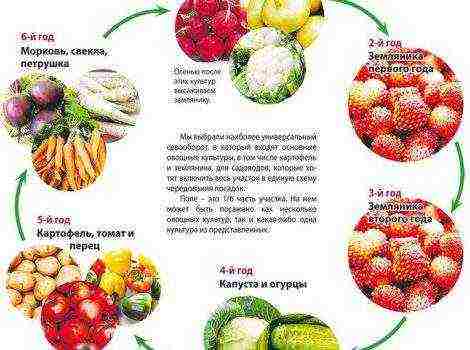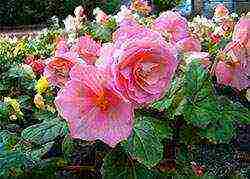Content
The area for irises should be chosen open to the sun. Slight shading for 2 ... 3 hours a day does not reduce the quality of flowering. The protection of the site from the wind is of great importance. Varieties with very large flowers and high peduncles are recommended to be tied in advance with soft braid or matting to the supporting stakes.
The soil should be neutral or slightly acidic. It is very important that the site and subsoil are not excessively wetted. The latter is permissible for Siberian, many species and varieties of Spuria irises, to some extent for Japanese, but by no means for bearded ones. It is impossible to plant bearded irises in large clumps in low areas near water bodies, since they suffer not only from excess moisture, but also from the invasion of a naked slug that eats foliage at night.
The soil must be well drained. These perennials are not very demanding on the mechanical composition of soils, but bearded irises are difficult to grow on heavy, highly clayey soils. Light loam or even clean sand is preferable.
 There can be no general guidelines for fitting and component selection. Perennial lupine, daylilies, peonies can be recommended as successful components from perennials for iris; the last two plants often accompany irises in nature, for example, in forest glades, along forest edges in places of natural growth.
There can be no general guidelines for fitting and component selection. Perennial lupine, daylilies, peonies can be recommended as successful components from perennials for iris; the last two plants often accompany irises in nature, for example, in forest glades, along forest edges in places of natural growth.
When laying complex borders, the so-called mix-borders, bearded iris is combined with each other according to the height of the bushes, the contrast of the color of the flowers, and the timing of flowering.
On a personal plot, iris, taking into account its characteristic features, can be planted both in composition with other perennials, and independently. Planting along garden paths is especially effective. Two types of iris of our flora can be a wonderful decoration of any reservoir: smooth iris (I. laevigata) and marsh iris (I. pseudacorus).
The density of irises depends on the purpose of planting, species and varieties. You can create a colorful spot from irises of the same variety by placing 3 ... 5 young bushes in a triangle or in a circle every 20 ... 25 cm. When creating an iris border, you should use low-growing varieties, placing plants in two or three rows with a distance of 15 ... 20 cm between them, between bushes - 10 ... 12 cm. To create multi-colored groups, medium-tall varieties are most suitable, which should be planted at a distance of 30 ... 35 cm from the bush.
Before planting irises, the site is dug to the depth of the bayonet of an ordinary garden shovel. At the same time, it is very important to eliminate dangerous weeds. If the soil is heavily clogged with the rhizomes of wheatgrass, thistle, sow thistle or ditch, then it is best to sift the entire top layer through a roar when digging, this will free you from fighting them for several years. Wheatgrass and other perennial grasses are especially difficult to get rid of if there are Siberian and Japanese irises in the planting. Cereals grow into the interweaving of iris rhizomes and it is impossible to weed them out.
If the area is too wet, grooves must be made to drain excess moisture. Acidic soil needs to be improved by adding lime. Good garden soil or sand is added to a heavy-textured soil.
Rhizomes of bearded iris can be planted in early spring, in summer after flowering ends, when active root growth begins, and in the pre-autumn period, and in the southern regions - in autumn. Before planting, the root system is cut to a length of 8 ... 10 cm from the rhizome, and for summer and autumn planting, a bunch of leaves is cut off by 2/3 of the length.An annual link, the so-called scapula, with a bunch of roots and a fan of leaves appears as a planting unit.
The planting method depends on the type of iris. For bearded irises, a mound is made at the bottom of the hole, the roots are straightened over this mound, then sprinkled with earth and tightly squeezed with your hands or even pressed down on the soil in two or three places with your foot. A well-planted iris scapula should not fall down when slapped on it with your palms, but, shuddering, remain upright. The rhizome should be level with the soil surface. After planting, the plant is watered. Siberian, Japanese, Spuria, Onkotsikly and Regelia irises are planted so that the rhizomes are at a depth of 3 ... 5 cm.
Many flower growers classify irises as a group of extremely undemanding perennials. Yes, indeed, sometimes they, left to themselves, continue to grow, bloom and fight for their lives with weeds. Thus, first of all, the most resistant of the species can behave: marsh, Kempfer, Siberian, Monier and some others. A number of varieties of bearded irises, primarily of the old selection, are also distinguished by their great vitality.
Most of the varieties of modern selection are demanding for care. Throughout the growing season, it is necessary to loosen the soil, remove weeds, in dry summers, especially during the flowering period, which often coincides with the absence of rain, water.
In early spring, as soon as the snow has melted, it is necessary to carefully rotate the shelter with a garden pitchfork or a pole to give access to air. There is no need to rush to remove the winter shelter, especially in the north-west, where, following the melting of snow, there are often quite strong frosts. A shelter made from pine paws, twigs and fallen leaves can be burned and the ash can be used as fertilizer. Leaves and links of rhizomes that have died out during the winter are removed.
One should not rush to conclusions regarding wintering. In the middle lane and in particular in the Moscow region in early spring, after wintering, irises for the most part look sad. It seems that many plants have died. But after a week or two, they come to life. Early vegetation is in a hurry to discard the buds, the later ones turn green and quickly grow back the leaves. In mid-May (in the north-west at the end) or at the beginning of June, the overwintering of varieties is recorded. You can use a three-point scale:
- the first - the leaves of the plants are damaged, but the flower buds are alive, flower stalks develop from them;
- the second - the leaves and flower buds are killed in the bushes, dormant buds awaken in some places on the rhizomes;
- the third - the bushes are completely dead and lifeless.
Of the pests in the early spring period in the Moscow region, the most dangerous caterpillar of the moth butterfly. She is especially active in gnawing flower stalks and leaves in dry springs. The scoop is destroyed by introducing granosan into the soil at the base of the bushes (you must try to get the poison under the bush). For the prevention of granosan or another drug that kills insects, it should be applied at the end of the second or third decade after the start of the active growing season.
A feature of bearded irises is the location of fibrous roots at the very surface of the soil, therefore, iris bushes react to an excess of fertilizer by yellowing the leaves. In the Moscow region, the best result is given by three-fold fertilizing with mineral fertilizers:
the first feeding, nitrogen-phosphorus (3: 1), is applied at the beginning of the growing season of plants;
the second full, nitrogen-phosphorus-potassium (3: 1: 3), - during the budding period;
the third, phosphorus-potassium (1: 1), should be timed to the period of active root growth, that is, in the Moscow region 2 ... 3 weeks after the end of flowering.
On very poor soils, the amount of dressing can be increased, on fertilized soils, on the contrary, it can be reduced. It should be remembered that before fertilizing the soil, if it is dry, it is necessary to water abundantly.
Before flowering, you need to prepare pegs 100 ... 150 cm long and a soft garter material.
If the weather is dry, the plants need watering; they bloom longer and better when the soil under them is moist during the flowering period. Japanese and Siberian irises are especially hygrophilous during the flowering period. It is better to water in the evening, trying not to spray the flowers. It is better to cut off inflorescences for bouquets in the morning. For transportation, the most convenient inflorescences, in which the first flower is prepared for opening.
Withered flowers should be removed, and at the end of flowering, if seed collection is not expected, the inflorescences are cut off at the base.
Of the diseases and pests for irises, the most dangerous are bacteriosis, or rot of rhizomes, and damage to foliage by gladiolus thrips. Bacteriosis, or bacterial wet rot of rhizomes, caused by several types of bacteria, is especially dangerous for the newest foreign varieties of bearded irises. Many tens and hundreds of imported foreign varieties disappeared without a trace from this disease. This disease takes on the most dangerous forms in the warm, humid period of summer. It is not difficult to recognize the disease. First, the ends of the leaves turn yellow, then the ends of the leaves turn brown, finally a fan of leaves falls to the ground, it easily breaks off at the base with a part of the rhizome rotting and emitting an unpleasant odor.
If the disease is detected in time, it can be quickly eliminated. The affected part of the rhizome is cut out to fresh healthy tissue and destroyed. The cut is poured with a thick solution of potassium permanganate and left open, accessible to the rays of the sun, which kill bacteria. Aging, too neglected bushes are more affected by bacteriosis. When re-planting irises in areas where bacteriosis has already been noted, the planting holes are disinfected with formalin or bleach. The planted rhizomes are etched with 0.2% fundozol or quinosol, or powdered with TMTD, zineb.
In the second half of summer, if it rains very abundantly, naked slugs appear in large numbers in the Moscow region, eating the foliage of irises, gladioli and other plants. During the day, they hide under stones and clods of soil. In small areas, slugs can be collected and destroyed; in large tracts, they are scared away with a superphosphate powder.
In the second half of summer, the foliage of bearded irises is often covered with large brown, slightly elongated spots. The death of leaf tissue can be caused by a fungus from the genus Heterosporium parasitizing the leaves, a similar disease is caused by a bacterium from the genus Xanthomonas. Affected foliage should be trimmed and destroyed. Damp weather and a lack of phosphorus and lime in the soil contribute to increased mottling.
In the Moscow region, many varieties of bearded irises need shelter for the winter. The most reliable shelter for perennials is snow, especially loose, not compacted. Each centimeter of such snow reduces frost by 1 ... 1.5 ° С. That is, at -20 ... 25 ° С and a snow cover of 20 ... 25 cm in the upper soil layer in the zone where iris rhizomes lie, the temperature drops to 0 or -1 ... 2 ° С. Practically, with a snow layer of 30 ... 35 cm for irises, the threat of freezing is not created.
The first rule of preserving irises in winter: you should not rush to shelter in the same way as you should not rush to remove them in spring. It is necessary to wait out the light autumn frosts, and only when the frost really seizes the ground (in the Non-Chernozem zone and its northern regions in November), can the most delicate varieties be covered. The foliage is cut at a height of 10 ... 15 cm.
Various materials are used for shelter: spruce branches, dry fallen leaves, straw, sawdust, dry peat, moss, etc. The insulation material must be dry, it is placed on the bushes in mounds 15 ... 25 cm high, in Kazakhstan and Siberia at 1.5 ... 2 times higher. If foliage is used, it is necessary to put a bunch of spreading branches under it on the iris bush, this will prevent damping. An unsuccessful shelter can only worsen wintering.
Rainbow - this is how the name of this plant is translated.It is so different from others in the structure of the flower and the variety of varieties that it can compete with orchids, and if we talk about color: indeed, the whole rainbow spectrum is laid in their color diversity. Images of iris are found on many ancient heraldic coats of arms and bas-reliefs in temples. If you are a bit of an artist at heart, and you want to admire the rainbow in your garden on summer evenings, then irises should certainly decorate your garden.
Iris belongs to the iris or iris family, hence its second name - iris. Six petals are arranged in two tiers. The three outer petals are pulled down and are called halyards, the three inner petals are called standards, they are raised up. There are three pistils and stamens. Below the flower on the stem is a sheet of the wrapper. Leaves are straight, fan-shaped, in each shoot up to 9 pieces. In the fall, in place of the flower, a fruit-box appears, which has three valves, when ripe it cracks.
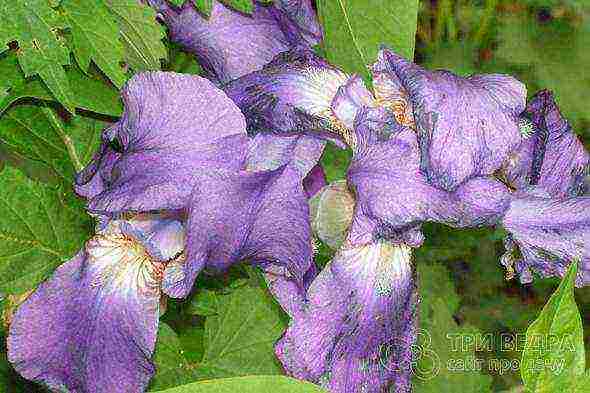
Irises are subdivided into bulbous and rhizomatous. Bulbous plants include Dutch irises. They can often be seen in bouquets. Small-bulbous grow in Asia and the Caucasus.
Rhizome irises are common in our gardens. The rhizome is located almost on the soil surface, has a fairly branched shape and consists of well-distinguishable parts - annual increments. Strong peduncles grow in height from 20 to 120 cm.
Depending on the height, irises are subdivided into:
- dwarf 15-20 cm,
- undersized - up to 40-50 cm,
- medium height 50-70 cm,
- high - 70-120 cm.
The flowering period is June. Early varieties bloom in the first days, middle ones - in mid-June, late ones - in the second decade.
The most popular of the rhizome irises are the bearded ones. You cannot confuse them with others, because on the petals, inclined to the ground, there is a fluffy groove - a beard. She shows insects the way to nectar.
By color, irises are also divided into groups:
- monochrome,
- two-tone,
- bicolor.
In certain varieties, the beard can also be distinguished by color.
Pick-up location
Irises need neutral, well-cultivated soil, moisture-permeable, even slightly alkaline. It is necessary to choose sunny, high places with a slight slope for water drainage. They do not tolerate stagnant water at all, therefore, drainage, sand, and also a little well-rotted humus or compost must be added to clay soils. When planting, it must be borne in mind that this plant does not grow on acidic soils, does not tolerate soils oversaturated with organic fertilizers, and does not bloom in the shade.
Growing methods
Irises are grown in slices - parts of rhizomes called "shoulder blades". Bulbous (for example, Dutch) propagate exclusively by bulbs.
Landing
Dig up the soil on a shovel bayonet, add 60 g of superphosphate, a bucket of humus, 2-3 glasses of wood ash, coarse river sand (if the soil is clay). All components are well mixed, level the bed.
For disinfection, the iris cut is kept for 30-60 minutes in a solution of potassium permanganate or Hom preparation. Then they are dried, the sections can be covered with crushed charcoal to protect the plant from possible diseases.
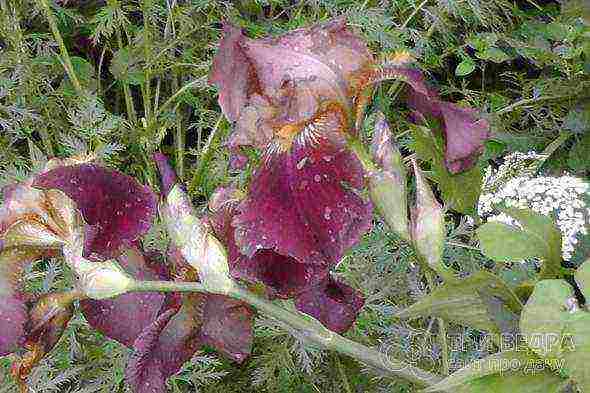
If the soil is loamy or clayey, it is advisable to pour large expanded clay or broken brick to improve water permeability when planting on the bottom of the hole. Then pour a mound of earth, place the rhizome on it, spread the roots and sprinkle them with earth, compact the soil around the plant with your hands. Delenki are planted shallowly, making sure that the upper part of the rhizome is not covered with earth. After planting, the plant needs watering.
Planting and division times
Irises are planted most often after flowering, in late June - early July. At this time, new roots are just beginning to grow. They are very fragile and if they break, then the next ones will grow back only after a year.
In autumn, the roots become coarse and tough. At this time, irises can also be transplanted, but then you should take care of shelter for the winter.
Planting or division can be carried out in early spring. With a knife, the overgrown plant is divided into several parts, so that each division has a developed rosette of leaves. Pruning leaves and roots by 1/3 or half.
Irises are transplanted every 3-5 years. Every year, new links of rhizomes are formed on the side, and flowering occurs on new side ones, the old ones gradually die off. And in the center of the planting there are dry, intertwined rhizomes. The transplant period can be postponed if you carefully cut out old dried rhizomes with a knife.
Care
Weeding, tying tall peduncles to pegs, removing withered flowers and leaves, occasional watering, top dressing as needed, gentle loosening of the soil, because the rhizome is located on the soil surface. Closer to autumn, foliage can be shortened by a third or half.
Irises lay flower buds in the fall, for this they need a lot of sunlight. Make sure that nearby overgrown plants do not shade them.
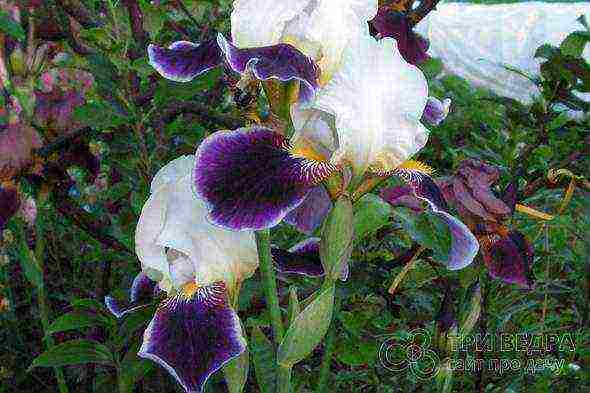
Well-rooted irises do not require special shelter, but given the weather conditions, try to cover the bed with them with dry foliage of broadleaf trees in late autumn: maple, oak or chestnut.
Watering
Bearded irises store a significant amount of moisture and nutrients in the rhizomes, so watering is necessary in the following cases:
- the plant was planted recently and has not yet taken root,
- before feeding,
- in hot dry weather.
Water in the evening, under the root, with warm, settled water, without eroding the soil around the rhizomes.
Top dressing
Feeding should be done with caution, because it is necessary to apply exactly those fertilizers that are lacking in the soil. This plant cannot be overfed with nitrogen fertilizers, cannot stand feeding with fresh manure and not decomposed compost. All fertilizing is carried out on wet soil.
In May, during the growing season, it is recommended to feed with urea and potassium sulfate: per 1 m²: per 5 liters of water - 0.5 tbsp. l. urea and potassium sulfate, as well as sprinkle the soil with ash - 1 cup.
During the budding period, irises are fed with Kemir or Agricola complex fertilizer for flowering plants (5 g per 5 liters of water - per 1 m²), and wood ash is also scattered - 1 glass.
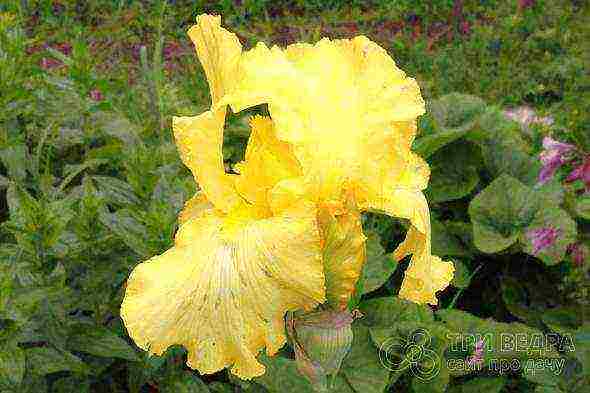
In July, the third fertilizing of phosphorus-potassium is carried out: 50 g of superphosphate are introduced per 1 m². Fertilizers are applied to wet soil, followed by loosening.
Pests
- Root onion mite: before planting, the rhizome is soaked for a few minutes in a 0.4% Phosphamide solution or applied to the soil.
- Gladiolus thrips: per 1 m²: Conifor preparation, 0.1 ml - 1 liter.
- Slugs: Thunderstorm, granules; Metaldehyde, granules.
Diseases
- Heterosporium or leaf spot: 1% solution of copper sulfate or ferrous sulfate (10 g - 1 l of water), Bordeaux liquid (30 g - 1 l of water), foundationol (1 g - 1 l of water).
- Rot of rhizomes: Hom (80 g - 10 l of water - soaking the intact rhizomes remaining after pruning).
- Rust: collecting and burning infectious shoots and treating plants; Fitosporin, Skor (2 ml - 10 L), Hom (40 g - 10 L), Topaz (4 ml - 10 L), 1% solution of copper sulfate or ferrous sulfate (10 g - 1 L of water), Bordeaux liquid (30 g - 1 l of water);
- Gray rot: with an excess of nitrogen, freezing of rhizomes, high humidity; Pure flower (2 ml - 5 L of water), Hom (40 g - 5 L of water).
Popular varieties of bearded irises
- Saltans Palace (cherry),
- Florence Dayton (white top, cherry bottom petals, corrugated),
- Pink Taffet (pink),
- Pati Dress (salmon yellow),
- Glowing Seraphin (white with yellow beard),
- Cimmaron Strip (orange-burgundy),
- Visial Arts (lilac, corrugated).
Back

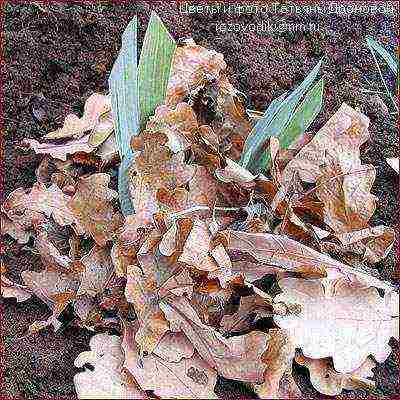
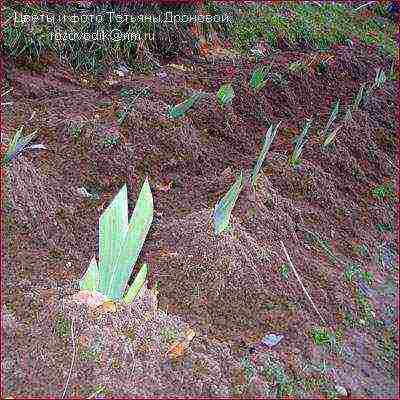

 Among the bearded irises, there are no "water lovers". They are afraid of excessive moisture, and only during the flowering period does the need for water increase.
Among the bearded irises, there are no "water lovers". They are afraid of excessive moisture, and only during the flowering period does the need for water increase.
Plantings should be placed in sunny areas using raised beds of any configuration with a height of at least 20 cm. On flat areas further care is difficult.
Heavy clay soils should be improved by adding sand and peat, strongly acidic soils should be neutralized with ground chalk or ash. It is dangerous to apply fresh organic fertilizers, it is better - old 3-5 year old compost or humus.
You can place the rhizomes in one or two rows. The distance between plants is 30 cm for tall ones and 20 cm for dwarf irises. The distance between the rows is 50 cm. In the case of placement in 2 rows, a "back to back" planting gives good results (with the cut off part - to the edge of the bed, with a bunch of leaves - to the middle of the bed).
Throughout the season, the rhizome should be on the surface of the soil (only roots in the soil!) - this is a guarantee that in the event of hot, humid weather such a dangerous disease as bacteriosis will not develop.
It is possible to prepare iris planting for wintering in a reliable way, proven for more than ten years.
In late September - early October (depending on the weather), plantings are cut "on a cone" at a height of 12-15 cm (as when planting), the rhizomes are covered with dry oak leaves on all sides, and the soil is spilled tightly to a height of 7-10 cm. But when there are many landings, it is laborious. Therefore, it is easier to cover the irises with oak leaves after pruning, lightly sprinkle with soil and immediately cover with a dense non-woven material of grade 60 or more dense, throwing it on a simple low frame made of arcs or boards. Sand, sawdust, sphagnum, peat cannot be used for shelter, as they strongly absorb moisture.
In the spring, immediately after the snow melts, the oak "coat" is removed, the leaves damaged by frost are cut off, and the rhizomes are freed from the ground. For prophylactic purposes, plantings are spilled with a weak solution of potassium permanganate, Tiovit Jet or HOM (copper oxychloride).
They are fed with nitrogen fertilizers.
In case of return frosts in May, you should always have a non-woven material on hand to protect flower buds from freezing. Cover only against frost!
Further care:
Watering - as needed.
Top dressing - in May and June with complex mineral fertilizers such as "Kemira", in July - with phosphorus-potassium fertilizers. Excellent results are obtained from the use of ash during the period when flower buds are laid.
Against thrips: 2-3 times per season (in mid-May, early June, early July) - treatment with Actellik or any other drug against thrips.
In the phase of active growth of young rhizomes (after flowering), the so-called "stretching phase", when the extreme powerful leaves of irises are torn, giving growth to young roots and young rhizomes - it is especially important to ensure that the rhizome does not sink into the soil and water does not flow into the emerging cracks ... Otherwise, bacteriosis may develop. Aging, yellowing extreme leaves are regularly cut off at the very rhizome, cleaning out all their remnants.
After flowering, the peduncles should be carefully broken off or cut off at soil level.
13,579 views.
Back
 The delicate and unusually beautiful iris flower, as it is also popularly called the iris or cockerel, has been planted in gardens and front gardens for more than two millennia. This plant is rather unpretentious, therefore it is found on all green continents. Now there are about 250 species that can grow in various climatic conditions. For example, some varieties, the corresponding photos of which with the names are attached, feel great in cold Siberia, in the Urals and in the temperate climate of the Moscow region.
The delicate and unusually beautiful iris flower, as it is also popularly called the iris or cockerel, has been planted in gardens and front gardens for more than two millennia. This plant is rather unpretentious, therefore it is found on all green continents. Now there are about 250 species that can grow in various climatic conditions. For example, some varieties, the corresponding photos of which with the names are attached, feel great in cold Siberia, in the Urals and in the temperate climate of the Moscow region.
Legendary flower
The very word "iris" in translation means "rainbow". For the first time, the flower was described by Hippocrates, who gave it a name in honor of the goddess of the rainbow Iris. According to the legend, after Prometheus brought fire to people, the sky lit up with a rainbow. The lay people watched this manifestation of heaven all day, all evening and night. And in the morning everyone saw that the earth was covered with outlandish flowers, similar to a rainbow. So they called them - irises.
The famous city of Florence, which means "blooming", owes its name to the same irises growing in the vicinity.About 60 species of these flowers now grow on the territory of Russia. Almost all of them are frost-resistant and unpretentious.
Types of irises
Irises are striking in their species diversity. Iris can be tall and dwarf, small-flowered and with large flowers. Their color is so varied that it is sometimes very difficult to describe it. The flowering times of different varieties are also different, so if you wish, it is not difficult to create a garden composition from irises alone.
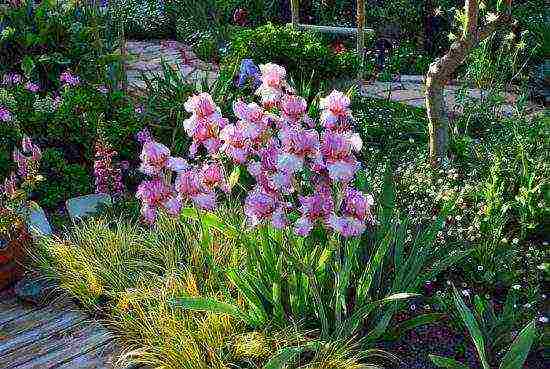
Irises in the garden
Botanists divide irises into root and bulbous. The former, in turn, are divided into bearded and beardless.
- Bearded irises are most commonly found in gardens. On the side of the lower petals closest to the base, they have bristly villi. This is the beard. The species is divided into six groups, differing from each other in plant height, size and flower shape. In summer, in cold areas, they take pride of place in flower beds. Due to the similarity with the epiphytes of the tropics, irises in Siberia are tacitly called "northern orchids".
- Beardless irises - differ from the previous ones in the shape of the flower and the absence of a fleecy strip. Includes four groups.
- Bulbous irises. Representatives of these iridescent whales are characterized by very early flowering, literally immediately after the snow melts.
Advice. If there are several types of irises of different heights in the garden, it is best to create stepped compositions from them.
What irises do well in the Urals and Siberia
For such a cold climate, you need to select irises, the features of which are rapid growth, endurance and unpretentiousness.
Representatives of bearded irises are not all able to endure frosty winters. But some varieties do well in harsh conditions. These are:
- Ruby Morne is a tall variety. It is endowed with ruby-red flowers of large size with corrugated petals.

Ruby Morne
- Hang-glider - also refers to tall ones. Its large flowers are quite interestingly colored: the lower petals are dark blue, the upper ones are white, and the beard has a bronze tint.
- Just Crazy is a fairly young variety. The color of the flower is honey-coffee. The petals located at the bottom have a richer hue. Strongly crimped.
- The white moth is a low grade. The flower is white with yellowish beards.
- Wish upon e star is a dwarf iris. Its small flowers look very impressive: purple, almost black petals and a white and yellow beard.
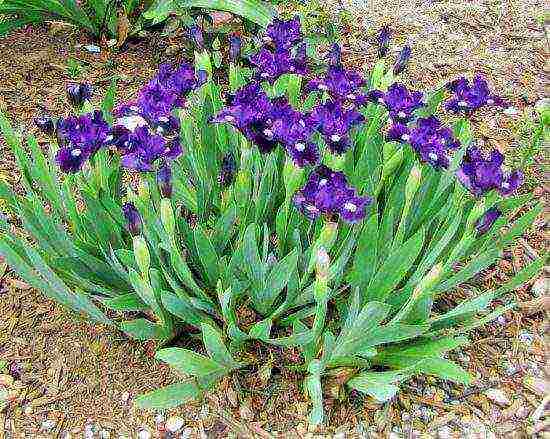
Wish upon e star
Beardless irises, namely their Siberian group, are very well adapted for growth and development in a continental climate. Iris of these varieties have large flowers and are completely lacking in aroma. Previously, the color range of Siberian varieties was violet-blue, but now varieties with pure white flowers, lavender, etc. have appeared.
- Hubbard is a tall iris with large flowers up to 15 cm in diameter. The lower petals are white with a yellowish tinge, the upper ones are purple.
- The Queen's Show is a tall variety with white flowers.
- Teal Velvet is a tall iris with blue-violet flowers. Closer to the base, the petals brighten.

Teal Velvet
- Rikugi Sakura is a tall bicolor iris. The lower petals are purple, and the upper ones are purple.
Advice. So that irises do not degenerate and every year they bloom profusely, they need to be transplanted periodically: bearded - once every 3-4 years, Siberian - once every 10 years, bulbous - once every two years, and preferably annually.
Bulbous irises. In cold climatic zones, the net group is widespread. They bloom before everyone else - the flowers literally crawl out from under the snow. They are endowed with a small stature, about 15 cm, so they look great on the alpine slides. For example: Danford's Iris are small, bright yellow flowers with brown blotches. Its growing period is very short.
What irises are best to grow in the suburbs
For cultivation in the Moscow region, zoned varieties of irises are more suitable.Of the bearded, we can recommend:
- The Snow Waltz is a highly corrugated, pure white flower and yellow beard. The iris itself is tall.
- Lilac glory - lilac petals, red beard.
- Clear glade - the lower petals are amethyst, the upper ones are creamy.
These varieties do not require much attention. At the same time, they look very decorative. Foreign varieties recommended for growing in the middle lane:
- Dressed Maine is one of the newer varieties. This iris has black-purple, velvet-like flowers. The petals are strongly corrugated, the beard is bright yellow.
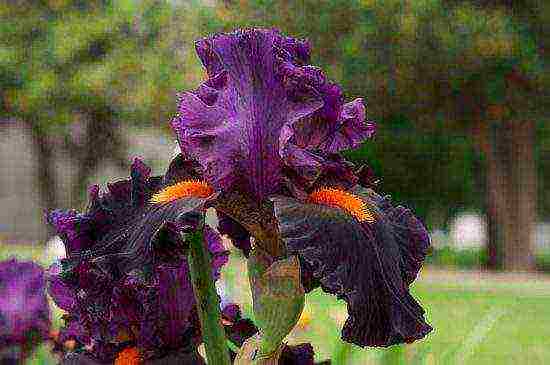
Dressed Maine
- Elizabeth Noble is a tall iris. The lower petals are dark purple and the upper ones are white.
- Pussiket Pink is a representative of undersized irises. The flowers are pink with coral beards.
Advice. Varieties of foreign selection, in the first year after planting, in order to avoid freezing, it is better to cover for the winter.
Of the Japanese irises in the gardens of the Moscow region, only those that were bred in Russia can be grown. If we take others, for example, of Japanese selection, they either will not bloom in these places, or they will die in the frosty winter.
They have proven themselves to be excellent:
- Vasily Alferov is tall with a large purple flower up to 20 cm in diameter.
- Altai - flower petals are purple, and a small tongue is yellow.

Altai
- Happiness ghost - the flower has a flat appearance and six petals. The flower itself is white with lilac stains that disappear with age.
The world of irises is very diverse and diverse. Breeders regularly develop new varieties. Such a rich choice allows you to grow on the site, even in cold areas, a real iris garden and admire this rainbow beauty for a long time.
Blooming terry irises: video
